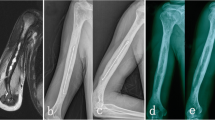Summary
Osteomyelitis of long bones represents a severe complication during fracture healing. If ongoing infection occurs despite reoperation and if antibiotic treatment is of no benefit, reaming of the medullary canal may be beneficial. We investigated the long term follow up (minimum 2 years) of patients submitted to reaming of the medullary canal to evaluate the efficacy of this method. Criteria for successful procedure: no further operative procedure/ antibiotic treatment. 32 patients out of 37 were followed over a 9 year period. Mean incidence of surgical treatment for osteomyelitis prior to reaming: 3.2 operations. Mean duration until reexamination after reaming: 3.7 years. 89% of patients had a full range of motion upon reexamination, in the others further articular injuries were present. 84.3% of patients were working in the same profession as prior to the fracture, 72% were active in sports again, 97% of patients were pain free. One otherwise healthy patient suffering from sclerosing osteitis (Garré) died during reaming of the femur due to bone marrow embolism to the lung. Reaming of the medullary canal has a high rate of curing osteomyelitis even after several previous attempts of surgical revisions and/or antibiotic treatment. The most likely mechanism is based on improvement of local perfusion. During surgery care must be taken not to provoke pulmonary embolization. Intraoperative monitoring by pulmonary artery catheter should performed; reaming should be immediately discontinued, if a rise in pulmonary artery pressure occurs.
Résumé
L’ostéomyélite est une complication sévère après une fracture d’un membre. Si l’infection ne cesse pas malgré traitement antibiotique et réintervention, un alésage médullaire peut être proposé. Nous avons étudié avec un recul minimum de 2 ans les patients ayant bénéficié de ce traitement. La durée de l’infection de 32 des 37 patients fut de plus de 9 ans. Les critères de bons résultats furent l’absence de prise d’antibiotiques et d’intervention chirugicale supplémentaire. Les patients avaient bénéficié en moyenne de 3,2 opérations avant la réalisation de l’alésage, et le recul moyen après réalisation de l’alésage fut de 3,7 années. Au contrôle 89 % des patients avaient des amplitudes articulaires libres, 84,3 % des patients avait repris leur ancien travail, 72 % refaisaient du sport, 97 % des patients ne présentaient plus de douleurs. Mais une jeune femme est décédée d’une embolie graisseuse durant l’aléssage. L’alésage du canal médullaire permet de guérir bon nombre d’ostéomyélites même après plusieurs mois de traitement chirurgical et/ou antibiotique. L’explication physiopathologique est une amélioration de la perfusion sanguine osseuse. Néanmoins il faut faire attention au risque d’embolie graisseuse notamment par surveillance de la pression de l’artère pulmonaire.
Similar content being viewed by others
References
Aström J (1975) Peroperative effect of fenestration upon intraosseous pressure in patients with osteoprthritis of the hip. Acta Orthop Scan 46: 963–967
Böhler J (1965) Treatment of nonunion of the tibia with closed and semiclosed intramedullary nailing. Clin Orthop 43: 93
Böhm E, Müller KH, Reissig G, Maas F (1983) Vergleichende morphologische, klinische und bakteriologische Untersuchungen zur chronischen posttraumatischen Osteomyelitis. Unfallheilkunde 86: 57–64
Böhm E, Oelenberg W (1983) Die Bedeutung von Durchblutungsstörungen für den Verlauf der chronischen posttraumatischen Osteomyelitis. Unfallheillkunde 86: 482–488
Burri C (1989) Die chronische posttraumatische Osteitis. Helv Chir Acta 56: 845–856
Danckwardt-Lilieström G, Olerud S (1970) Intramedullary nailing after reaming. An investigation on the healing process in osteotomized rabbit tibias. Acta Orthopedica Scandinavica Suppl 134
Faupel L, Kunze K, Ecke H, (1986) Die Eigenblut-Antibiotika-Plombe als wirksame Therapie der chronischen Osteomyelitis. Unfallchirurgie 12: 110–113
Kelly PJ (1984) Infected nonunion of the femur and tibia. Clin Orthop Rel Res 15: 481–490
Klein MPM, Rahn BA, Frigg R, Kessler S, Perren SM (1990) Reaming versus non-reaming in medullary nailing: interference with cortical circulation of the canine tibia. Arch Orthop Trauma Surg 109: 314
Klemm KW (1986) Treatment of infected pseudarthrosis of the femur and tibia with an interlocking nail. Clin Orthop 212: 174
Lindgren L, Törholm C (1980) Intramedullary reaming in chronic diaphyseal oseomyelitis: a preliminary report. Clin Orthop 151: 215
Miller ME, Jesse R, Lawrence X (1989) Treatment of Infected Nonunion and Delayed Union of Tibia Fractures With Locking Intramedullary Nails. Clin Orthop 245: 233–238
Ochsner PE (1990) Chromnischer Infekt nach Osteosynthesen. Therapeutische Umschau. 47: 597–605
Pape H-C, Dwenger A, Regel G, Jonas M, Schweitzer G, Sturm JA (1991) Hat die Lungenkontusion und allgemeine Verletzungsschwere einen Einfluß auf die Lunge nach Oberschenkelmarknagelung ? — Ein tierexperimentelles Modell. Unfallchirurg 94: 381–389
Pape HC, Auf“m’ Kolk M, Paffrath T, et al (1993) Primary intramedullary fixation in polytrauma patients with associated lung contusion — a cause of posttraumatic ARDS? J Trauma 34: 540–547
Pape HC, Regel G, Dwenger A, Krumm K, Schweitzer G, Sturm JA, Tscherne H (1993) Influences on lung function by different methods of intramedullary femoral nailing in polytrauma patients. J Trauma 35: 709–716
Pape HC, Dwenger A, Grotz M, Kaever V, Negatsch R, Kleemann W, Regel G, Sturm JA, Tscherne H (1994) Does the reamer type influence the degree of lung dysfunction after femoral nailing following severe trauma? An animal study. J Orthop Trauma 8: 300–310
von Foerster G, Buchholz HW, Lodenkämpfer H, Lodenkämpfer U (1982) Behandlung der Osteomyelitis mit Antibioticazement. Chirurg 53: 709–715
Wittmann DH, Schimmel G, Seidel H (1978) Langzeittherapie mit Cephalexin in der Behandlung der chronischen Osteomyelitis: Knochenspiegelbestimmungen beim Menschen. Therapiewoche 28: 8946–8956
Zwipp H. Gotzen L, Haas N (1984) Die Markraumaufbohrung bei chronischer Osteomyelitis des stabilen Femur- und Tibiaschaftes. Chirurg 55: 260–263
Author information
Authors and Affiliations
Additional information
European Bone and Joint Infection Society Meeting, München, Germany, October 7–9, 1993
Rights and permissions
About this article
Cite this article
Pape, H.C., Zwipp, H., Regel, G. et al. Chronic diaphyseal osteomyelitis of long bones refractory to conventional therapy — Benefits and risks of reaming of the femoral medullary cavity. Eur J Orthop Surg Traumatol 5, 53–58 (1995). https://doi.org/10.1007/BF02716217
Received:
Accepted:
Issue Date:
DOI: https://doi.org/10.1007/BF02716217




